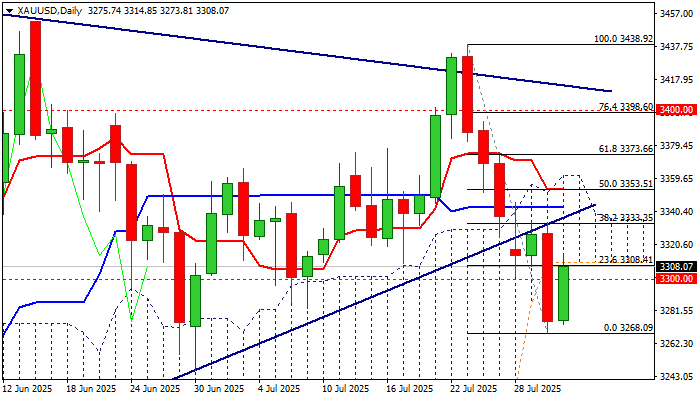Gold rebounds from a multi-week low, but upside momentum remains capped by strong resistance
Gold prices rebounded on Thursday from a one-month low at $3,268, recouping much of Wednesday’s sharp 1.6% decline.
The previous drop was driven by a stronger U.S. dollar, which surged on the back of recent U.S. trade agreements and growing expectations that the Federal Reserve will maintain its hawkish monetary policy stance—a view reinforced by the Fed’s post-meeting statement on Wednesday.
However, renewed trade-related uncertainty following President Trump’s latest tariff threats helped revive safe-haven demand and lifted gold prices.
The decline earlier in the week followed a false breakout above the upper boundary of a triangle pattern and saw gold breach a series of critical support levels—including the top of the daily Ichimoku cloud at $3,342, triangle support at $3,327, the cloud base at $3,310, and the key psychological $3,300 mark. Downside momentum was eventually halted by the rising 100-day moving average at $3,267.
The current recovery has managed to lift prices back above the $3,300 level, but all the previously broken support zones now act as strong resistance barriers.
A decisive break above the triangle’s lower trendline (currently at $3,334) is needed to ease bearish pressure. More importantly, a sustained rally above the top of the daily cloud, now around $3,361 (which also aligns with the 50% Fibonacci retracement of the $3,438–$3,268 decline), is essential to confirm a reversal and bring bullish momentum back into play.
Technical indicators remain mixed: the 14-day momentum is still in negative territory and most moving averages reflect a bearish configuration. However, the RSI is turning higher and the Stochastic oscillator is nearing a breakout from oversold levels, offering potential for further recovery.
If gold manages to clear key resistance zones, the recent sell-off could be interpreted as a correction within a broader bullish setup. On the other hand, failure to reclaim these levels would leave the metal vulnerable to further declines.
Ultimately, the balance between opposing market forces—such as geopolitical risks, macroeconomic uncertainty, and tariff tensions (bullish drivers), versus high interest rates and a strong U.S. dollar (bearish drivers)—will be crucial in determining gold’s short-term trajectory.
Res: 3334; 3353; 3361; 3381
Sup: 3267; 3247; 3207; 3199


